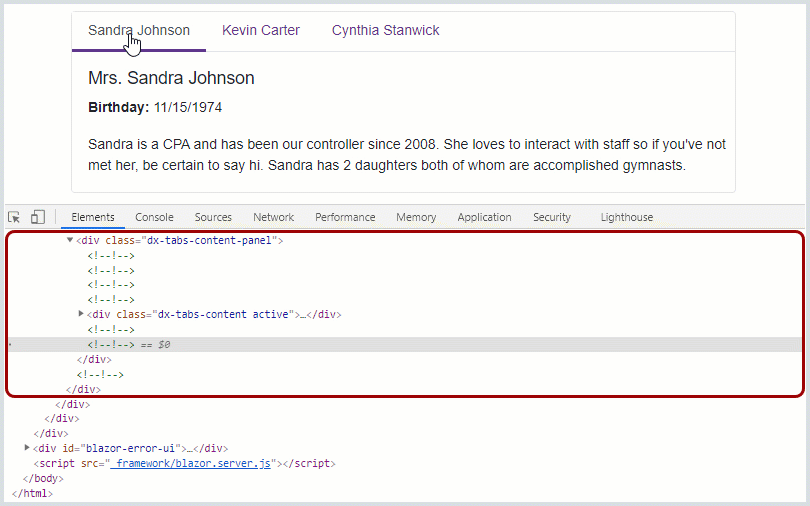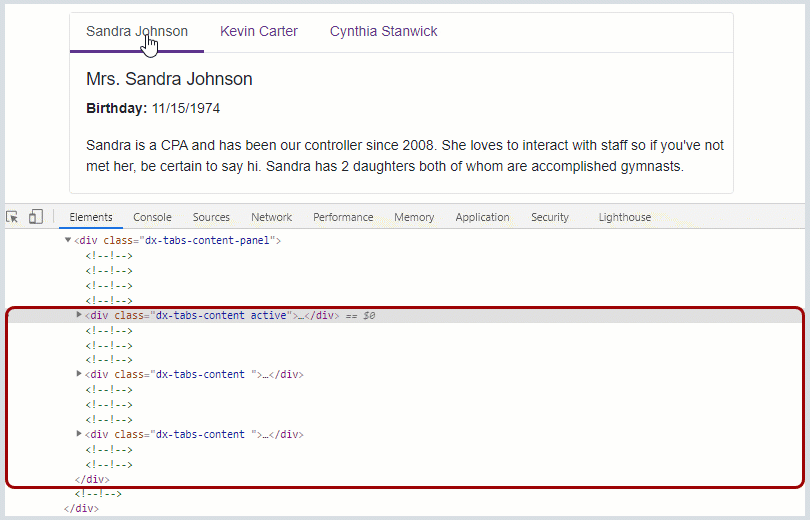DxTabs.RenderMode Property
Specifies how the DxTabs component loads tab content.
Namespace: DevExpress.Blazor
Assembly: DevExpress.Blazor.v21.1.dll
NuGet Package: DevExpress.Blazor
Declaration
[DefaultValue(TabsRenderMode.Default)]
[Parameter]
public TabsRenderMode RenderMode { get; set; }Property Value
| Type | Default | Description |
|---|---|---|
| TabsRenderMode | **Default** | A TabsRenderMode enumeration value. |
Available values:
| Name | Description |
|---|---|
| Default | The component initially loads only content of an active tab. When a user selects another tab, its content replaces the content of the previously active tab in the DOM. Note the component does not keep the tab’s state. |
| AllTabs | The component renders the content of all tabs in the DOM and maintains the tab’s state. This mode speeds up navigation between tabs, but can increase memory consumption. |
| OnDemand | The component initially loads content of an active tab, then loads the content of other tabs when a user selects them. In this case, the component maintains the tab’s state. Use this mode to improve performance of your application. |
Remarks
Use the RenderMode property to specify how the DxTabs component loads tab content.
Render modes include:
Default Mode
The DxTabs component initially only loads content of an active tab. When a user selects another tab, its content replaces the content of the previously active tab in the DOM. Note the DxTabs component does not keep the state of tabs.
<DxTabs RenderMode="TabsRenderMode.Default">
...
</DxTabs>

AllTabs Mode
In this mode, DxTabs renders the content of all tabs in the DOM and maintains the tab’s state.
The AllTabs mode speeds up navigation between tabs, but can increase memory consumption.
<DxTabs RenderMode="TabsRenderMode.AllTabs">
...
</DxTabs>

OnDemand Mode
In this mode, the component initially loads content of an active tab, then loads the content of other tabs when a user selects them. In this case, the component maintains the state of tabs.
Use the OnDemand mode to improve performance of your application.
<DxTabs RenderMode="TabsRenderMode.OnDemand">
...
</DxTabs>

Example
The code below demonstrates how to activate the OnDemand mode:
@inject Data.EmployeeService EmployeeService
@using Tabs.Data
@if (Employees == null) {
<p><em>Loading...</em></p>
}
else {
<div class="card w-75 ch-220 m-5">
<DxTabs RenderMode="TabsRenderMode.OnDemand">
@foreach (var employee in Employees) {
<DxTabPage Text="@(employee.FirstName + ' ' + employee.LastName)">
<div class="media demo-tab-page-content">
<div class="media-body pl-3 pt-3">
<h5 class="mt-0">@employee.Title @employee.FirstName @employee.LastName</h5>
<p><b>Birthday:</b> @employee.BirthDate.ToShortDateString()</p>
<p>@employee.Notes</p>
</div>
</div>
</DxTabPage>
}
</DxTabs>
</div>
}
@code {
IEnumerable<Employee> Employees;
protected override async Task OnInitializedAsync() {
Employees = (await EmployeeService.Load()).Skip(5).Take(3);
}
}